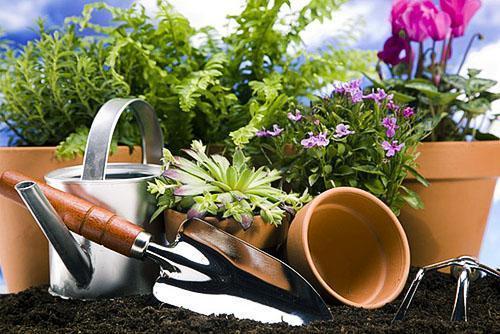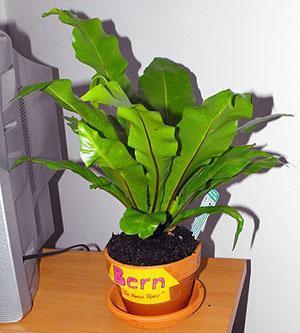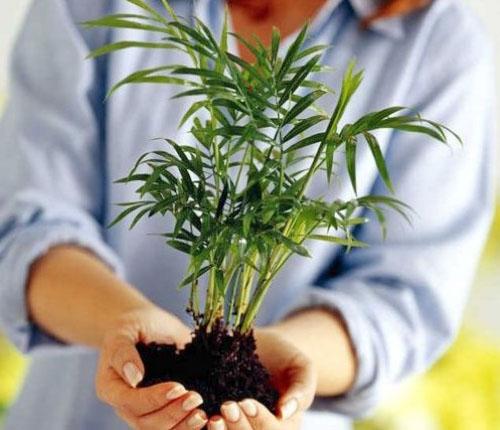Asplenium transplant and young plant care
 Asplenium is a type of fern that grows in warm tropical spaces. Of the many species of these plants, only a few can be grown as indoor crops. Asplenium care is easier than maidenhair, it forgives some mistakes in agricultural technology. However, the requirements for lighting, temperature conditions, humidity and watering must be observed so that the plant does not lose the beauty of the leaves.
Asplenium is a type of fern that grows in warm tropical spaces. Of the many species of these plants, only a few can be grown as indoor crops. Asplenium care is easier than maidenhair, it forgives some mistakes in agricultural technology. However, the requirements for lighting, temperature conditions, humidity and watering must be observed so that the plant does not lose the beauty of the leaves.
How to grow a big beautiful flower

After aging, all parts of the plant are carefully examined, including the roots. Pay attention:
- condition of the ground part;
- whether the root system is sufficiently developed and healthy;
- mold or other signs of an unhealthy environment on the surface of the soil.
 When examining the green plates, you need to pay attention to the absence of spots inside the frond, as this may be a sign of nematode nests. The plant is affected by the scale insect, the presence of which can be noticed by the brown tubercles on the surface of the leaves, closer to the stem. The spider mite will give itself out with a thin mesh on the underside of the leaf, and the aphid will turn the leaf brown. If the burn has gone along the edge of the plate, then this is a signal of incorrect content, which is fixable in caring for asplenium.
When examining the green plates, you need to pay attention to the absence of spots inside the frond, as this may be a sign of nematode nests. The plant is affected by the scale insect, the presence of which can be noticed by the brown tubercles on the surface of the leaves, closer to the stem. The spider mite will give itself out with a thin mesh on the underside of the leaf, and the aphid will turn the leaf brown. If the burn has gone along the edge of the plate, then this is a signal of incorrect content, which is fixable in caring for asplenium.
The plant is lightly watered so that it can be conveniently removed from the container without disturbing the roots. A healthy plant should entangle a clod of earth with roots, especially since a small pot is always used. Therefore, a living plant must form a voluminous non-decaying lump. If so, you need to inspect the surface to make sure that the roots are light, alive. If there are brown or dead parts, then the plant will have to work thoroughly. It should be borne in mind that the root system of the flower is restored slowly, and you need to trim it carefully and only the necessary parts.
 Asplenium transplant care is applied to the problematic root system. If there are no comments, transshipment is used, which slightly injures the plant. In a large pot with a previously prepared drainage layer, sprinkled with a substrate, the plant extracted from the dishes is lowered, sprinkled with prepared soil on all sides, watered to compact the composition. In this case, you should not deepen the asplenium. The neck should be just above the surface layer of the earth.
Asplenium transplant care is applied to the problematic root system. If there are no comments, transshipment is used, which slightly injures the plant. In a large pot with a previously prepared drainage layer, sprinkled with a substrate, the plant extracted from the dishes is lowered, sprinkled with prepared soil on all sides, watered to compact the composition. In this case, you should not deepen the asplenium. The neck should be just above the surface layer of the earth.
If there is a problem with the root system, it should be washed, dubious places removed, bathed in a fungicidal solution of weak concentration, dry the wounds with coal dust and planted in a new substrate, clean from any infection. After such a transplant, the plant will need a long recovery. Therefore, it is necessary to create conditions for plant survival. The rooting signal will be the emergence of new growth from the ground.
 You can watch the asplenium transplant process after purchase in the video at the end of the article. The choice of dishes is of great importance during transplantation. Plastic containers have less thermal conductivity, the ground in them is warmer, which is very important.But, in addition, the smooth inner surface has no pores where the roots could pass. Later, they will not be able to feed the plant, and when transshipped, they will come off. So for young plants that are often transplanted, you only need to take plastic dishes. For young plants, disposable plastic transparent cups are ideal. You can see how the roots develop.
You can watch the asplenium transplant process after purchase in the video at the end of the article. The choice of dishes is of great importance during transplantation. Plastic containers have less thermal conductivity, the ground in them is warmer, which is very important.But, in addition, the smooth inner surface has no pores where the roots could pass. Later, they will not be able to feed the plant, and when transshipped, they will come off. So for young plants that are often transplanted, you only need to take plastic dishes. For young plants, disposable plastic transparent cups are ideal. You can see how the roots develop.
In the future, a wide pot with a large number of drainage holes is selected for asplenium care. Expanded clay and sphagnum moss are laid with a drainage layer.
Expanded clay for drainage in specialized stores is sold impregnated with fertilizer mixtures that are harmful to the fern. Therefore, expanded clay before loading is soaked for several hours, changing the water.
Composition of land for transplanting asplenium
 A special requirement is imposed on the prepared planting stock. The earthen mixture should be light and breathable. The medium should be moderately acidic, which is achieved by the composition of the ingredients taken. For young plants, the substrate is made up in the following ratio:
A special requirement is imposed on the prepared planting stock. The earthen mixture should be light and breathable. The medium should be moderately acidic, which is achieved by the composition of the ingredients taken. For young plants, the substrate is made up in the following ratio:
- peat lowland - 2 parts;
- leaf land - 2 parts;
- humus with the addition of vermicompost - 2 parts;
- coarse river sand - 1 part.
To this composition, you need to add crushed charcoal and coconut fiber. This will keep the soil breathable and light.
When creating a nutrient substrate, you need to remember about its processing against bacteria and insect pests. Two weeks before using the land, it must be steamed, spilled with a strong solution of potassium permanganate and allowed to stand until planting to dry to a state of flowability, but with preserved moisture. You can use ready-made orchid primer after proper treatment. When planting a plant, you do not need to compact the earth.
Asplenium leaves are fragile, so all transplanting or transshipment operations must be carried out with caution.
Post-transplant care
 Right after transplanting, the plant is good to water heated and settled water. Place the plant under a hood to create a microclimate and place in a warm place. Remove the package after rooting. After transplanting and rooting, you can feed the flower after 3-6 weeks.
Right after transplanting, the plant is good to water heated and settled water. Place the plant under a hood to create a microclimate and place in a warm place. Remove the package after rooting. After transplanting and rooting, you can feed the flower after 3-6 weeks.
In the future, asplenium care is traditional, in compliance with the usual conditions of detention. The plant quickly gains green mass. New plates with threaded fronds grow from the center. Every year, the weight of the plant should double. With proper care, the life of the plant is about 10 years.